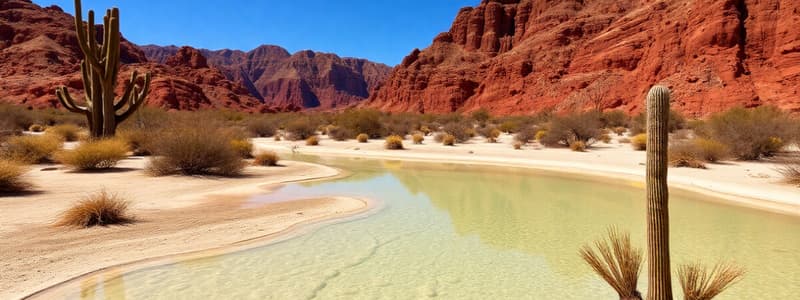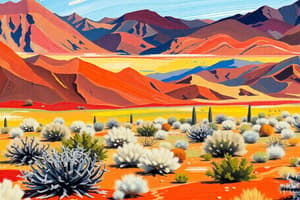Podcast
Questions and Answers
What distinguishes the hot and dry desert from other desert types?
What distinguishes the hot and dry desert from other desert types?
- It is the only desert type that does not form permafrost.
- It experiences extreme cold winters.
- It has significant snowfall during winter.
- It receives little to no rainfall throughout the year. (correct)
Which desert type experiences cool winters and mild summers?
Which desert type experiences cool winters and mild summers?
- Semi-arid Desert
- Coastal Desert (correct)
- Hot and Dry Desert
- Cold Desert
How does a cold desert primarily receive its precipitation?
How does a cold desert primarily receive its precipitation?
- Only during the summer months.
- In the form of snow throughout the year. (correct)
- Through coastal fog and dew.
- In the form of rain almost year-round.
What defines a semi-arid desert in comparison to a hot and dry desert?
What defines a semi-arid desert in comparison to a hot and dry desert?
What is a characteristic feature of tundra biomes?
What is a characteristic feature of tundra biomes?
What distinguishes temperate grasslands from savannas?
What distinguishes temperate grasslands from savannas?
Which characteristic is unique to hot and dry desert biomes?
Which characteristic is unique to hot and dry desert biomes?
In which regions are temperate grasslands primarily found?
In which regions are temperate grasslands primarily found?
What climate feature is essential for savannas?
What climate feature is essential for savannas?
How do desert biomes adapt to their environment?
How do desert biomes adapt to their environment?
Which statement accurately describes ecosystems?
Which statement accurately describes ecosystems?
What is the relationship between biodiversity and ecosystems?
What is the relationship between biodiversity and ecosystems?
What characterizes terrestrial biomes?
What characterizes terrestrial biomes?
Which of the following accurately defines biodiversity?
Which of the following accurately defines biodiversity?
Which statement is NOT true regarding ecosystems?
Which statement is NOT true regarding ecosystems?
Which statement correctly describes terrestrial biomes?
Which statement correctly describes terrestrial biomes?
In which type of biome is biodiversity highest?
In which type of biome is biodiversity highest?
Which of the following statements about forest biomes is true?
Which of the following statements about forest biomes is true?
Which terrestrial biome is characterized by minimal vegetation and extreme temperature variation?
Which terrestrial biome is characterized by minimal vegetation and extreme temperature variation?
What is a defining characteristic of tundra biomes compared to other terrestrial biomes?
What is a defining characteristic of tundra biomes compared to other terrestrial biomes?
What characteristic distinguishes temperate forests from tropical forests?
What characteristic distinguishes temperate forests from tropical forests?
Which biome is defined by having a growing season of 130 days and experiences long, cold winters?
Which biome is defined by having a growing season of 130 days and experiences long, cold winters?
What is a key factor in maintaining the grassland biome?
What is a key factor in maintaining the grassland biome?
Which of the following statements about savannas is true?
Which of the following statements about savannas is true?
Which type of grassland is typically associated with rich soil and abundant grass growth?
Which type of grassland is typically associated with rich soil and abundant grass growth?
Which of the following statements about the Arctic tundra is true?
Which of the following statements about the Arctic tundra is true?
What characterizes alpine tundra in comparison to other tundra biomes?
What characterizes alpine tundra in comparison to other tundra biomes?
What types of environments are considered freshwater ecosystems?
What types of environments are considered freshwater ecosystems?
What is a defining characteristic of estuarine ecosystems?
What is a defining characteristic of estuarine ecosystems?
Aquatic biomes consist of which of the following components?
Aquatic biomes consist of which of the following components?
Which of the following biomes can be found at altitudes around 10,000 feet?
Which of the following biomes can be found at altitudes around 10,000 feet?
Which of the following environments is part of marine ecosystems?
Which of the following environments is part of marine ecosystems?
Which of the following best describes aquatic biomes?
Which of the following best describes aquatic biomes?
How do freshwater ecosystems differ from marine ecosystems?
How do freshwater ecosystems differ from marine ecosystems?
Which statement accurately describes the biotic factors in marine ecosystems?
Which statement accurately describes the biotic factors in marine ecosystems?
Which statement best reflects the role of biodiversity in ecosystem resilience?
Which statement best reflects the role of biodiversity in ecosystem resilience?
How does biodiversity contribute to pharmaceutical development?
How does biodiversity contribute to pharmaceutical development?
What is a key benefit of biodiversity regarding climate change?
What is a key benefit of biodiversity regarding climate change?
Which of the following is not a direct benefit provided by biodiversity?
Which of the following is not a direct benefit provided by biodiversity?
Which option highlights a significant ecosystem service provided by biodiversity?
Which option highlights a significant ecosystem service provided by biodiversity?
What is one significant benefit of biodiversity in relation to ecosystems?
What is one significant benefit of biodiversity in relation to ecosystems?
Which of the following is classified as a provisioning service in ecosystem services?
Which of the following is classified as a provisioning service in ecosystem services?
How does biodiversity contribute to climate change adaptation?
How does biodiversity contribute to climate change adaptation?
Which statement accurately describes the significance of ecosystem services to human well-being?
Which statement accurately describes the significance of ecosystem services to human well-being?
Which of the following best exemplifies a regulatory service?
Which of the following best exemplifies a regulatory service?
Flashcards
Hot and Dry Desert
Hot and Dry Desert
A desert type that's very hot year-round and gets very little rain.
Coastal Desert
Coastal Desert
A desert with moderate temperature variations, cool winters and mild summers.
Cold Desert
Cold Desert
A desert type that is consistently cold year-round, receiving snow as precipitation.
Semi-arid Desert
Semi-arid Desert
Signup and view all the flashcards
Tundra
Tundra
Signup and view all the flashcards
Savanna climate
Savanna climate
Signup and view all the flashcards
Temperate grassland soil
Temperate grassland soil
Signup and view all the flashcards
Desert rainfall
Desert rainfall
Signup and view all the flashcards
Hot desert temperature
Hot desert temperature
Signup and view all the flashcards
Desert adaptation
Desert adaptation
Signup and view all the flashcards
Ecosystem
Ecosystem
Signup and view all the flashcards
Biodiversity
Biodiversity
Signup and view all the flashcards
Terrestrial Biomes
Terrestrial Biomes
Signup and view all the flashcards
What makes terrestrial biomes similar?
What makes terrestrial biomes similar?
Signup and view all the flashcards
Are terrestrial biomes always close together?
Are terrestrial biomes always close together?
Signup and view all the flashcards
What is the relationship between biodiversity and location in terrestrial biomes?
What is the relationship between biodiversity and location in terrestrial biomes?
Signup and view all the flashcards
Forest Biomes
Forest Biomes
Signup and view all the flashcards
Grasslands Biomes
Grasslands Biomes
Signup and view all the flashcards
Desert Biomes
Desert Biomes
Signup and view all the flashcards
Tropical Forest
Tropical Forest
Signup and view all the flashcards
Temperate Forest
Temperate Forest
Signup and view all the flashcards
Boreal Forest
Boreal Forest
Signup and view all the flashcards
Savanna
Savanna
Signup and view all the flashcards
Temperate Grassland
Temperate Grassland
Signup and view all the flashcards
Arctic Tundra
Arctic Tundra
Signup and view all the flashcards
Alpine Tundra
Alpine Tundra
Signup and view all the flashcards
Aquatic Biomes
Aquatic Biomes
Signup and view all the flashcards
Freshwater Biomes
Freshwater Biomes
Signup and view all the flashcards
Marine Ecosystems
Marine Ecosystems
Signup and view all the flashcards
Freshwater Ecosystem
Freshwater Ecosystem
Signup and view all the flashcards
Estuarine Ecosystem
Estuarine Ecosystem
Signup and view all the flashcards
What makes estuaries unique?
What makes estuaries unique?
Signup and view all the flashcards
What defines marine ecosystems?
What defines marine ecosystems?
Signup and view all the flashcards
Ecosystem balance
Ecosystem balance
Signup and view all the flashcards
Ecosystem resilience
Ecosystem resilience
Signup and view all the flashcards
Ecosystem services
Ecosystem services
Signup and view all the flashcards
Biodiversity and medicine
Biodiversity and medicine
Signup and view all the flashcards
Biodiversity: Why is it important?
Biodiversity: Why is it important?
Signup and view all the flashcards
Ecosystem Services: What do they provide?
Ecosystem Services: What do they provide?
Signup and view all the flashcards
Provisioning Services: What are they?
Provisioning Services: What are they?
Signup and view all the flashcards
Regulating Services: Examples?
Regulating Services: Examples?
Signup and view all the flashcards
Supporting Services: Why are they essential?
Supporting Services: Why are they essential?
Signup and view all the flashcards
Study Notes
Types of Desert Biomes
-
Hot and Dry: The most common desert type. Very hot (unlike freezing winters in tundra) and gets very little rain. Some don't see rain for years.
-
Coastal: Cool winters and long mild summers.
-
Cold: Cold all year, and receives all precipitation as snow.
-
Semi-arid: Cooler than hot and dry deserts.
Studying That Suits You
Use AI to generate personalized quizzes and flashcards to suit your learning preferences.




